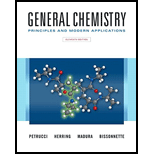
Concept explainers
(a)
Interpretation:
Equation for the substitution reaction of
Concept introduction:
Nucleophilic substitution reaction
Nucleophilic substitution reaction
The order of
Primary alkyl halide prefers to undergo
(b)
Interpretation:
Equation for the substitution reaction of
Concept introduction:
Nucleophilic substitution reaction
Nucleophilic substitution reaction
The order of alkyl halide reactivity towards
Primary alkyl halide prefers to undergo
(c)
Interpretation:
Equation for the substitution reaction of
Concept introduction:
Nucleophilic substitution reaction
Nucleophilic substitution reaction
The order of alkyl halide reactivity towards
Primary alkyl halide prefers to undergo
(d)
Interpretation:
Equation for the substitution reaction of
Concept introduction:
Nucleophilic substitution reaction
Nucleophilic substitution reaction
The order of alkyl halide reactivity towards
Primary alkyl halide prefers to undergo
Want to see the full answer?
Check out a sample textbook solution
Chapter 27 Solutions
Generl Chem Looself&mod Mst/et&stdy Crd Pkg, 11/e
- In a recent year, the United States produced 6.26 × 109kg1,2-dichloroethane and 3.73 × 109 kg vinyl chloride.Assuming that all significant quantities of vinyl chloridewere produced from 1,2-dichloroethane, what fraction ofthe 1,2-dichloroethane production went into making vinylchloride? What mass of hydrogen chloride was generatedas a by-product?arrow_forwardDetermine the DOU for the following molecules and suggest a structure for each. C5H7Br2ONarrow_forwardA compound with formula C7H12O is treated with sodium borohydride in methanol to yield 2,2-dimethylcylopentanol. Write a reaction scheme showing the structures of the reactant, the reagents, and the product. Will the product be optically active? Explain.arrow_forward
- A hydrocarbon C5H12 gives only one mono-chlorination product. Identify the hydrocarbon.arrow_forward2,2,3,3-Tetrabromopentane can be prepared by an addition reaction of excess Br2 with an alkyne. Draw the structure of the alkyne and name it.arrow_forwardFormaldehyde, H2C=O, is known to all biologists because of its usefulness as a tissue preservative. When pure, formaldehyde trimerizes to give trioxane, C3H6O3, which, surprisingly enough, has no carbonyl groups. Only one monobromo derivative (C3H5BrO3) of trioxane is possible. Propose a structure for trioxane.arrow_forward
- On a microscopic level, how does the reaction of bromine with an alkene differ from its reaction with an alkyne? How are they similar?arrow_forwardDraw the condensed structures and give the systematic names for all the alkenes with molecular formula C6H12, ignoring stereoisomers. (Hint: There are 13.) b. Which of the alkenes have E and Z isomers? c. Which of the alkenes is the most stable? d. Which of the alkenes is the least stable?arrow_forwardAssign the hydrogens in C7H14O to this structurearrow_forward
- An unknown hydrocarbon Q has a formula C6H12. Q Reacts with osmium tetroxide to give a diol R. When oxidized with KMnO4 in an acidic medium, Q gives two products. One product is propanoic acid and the other a ketone S. Provide reaction equations to identify the possible structures of Q, R and S.arrow_forwardWhat structural features help us identify a compound as(a) an alkane, (b) a cycloalkane, (c) an alkene, (d) an alkyne,(e) a saturated hydrocarbon, (f) an aromatic hydrocarbon?arrow_forwardDraw the structure of the carboxylic acids with formula C6H12O2 that do not contain any branchingarrow_forward
 Chemistry by OpenStax (2015-05-04)ChemistryISBN:9781938168390Author:Klaus Theopold, Richard H Langley, Paul Flowers, William R. Robinson, Mark BlaserPublisher:OpenStax
Chemistry by OpenStax (2015-05-04)ChemistryISBN:9781938168390Author:Klaus Theopold, Richard H Langley, Paul Flowers, William R. Robinson, Mark BlaserPublisher:OpenStax

